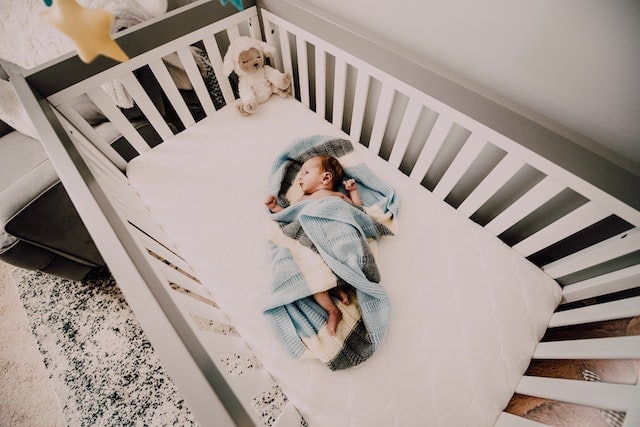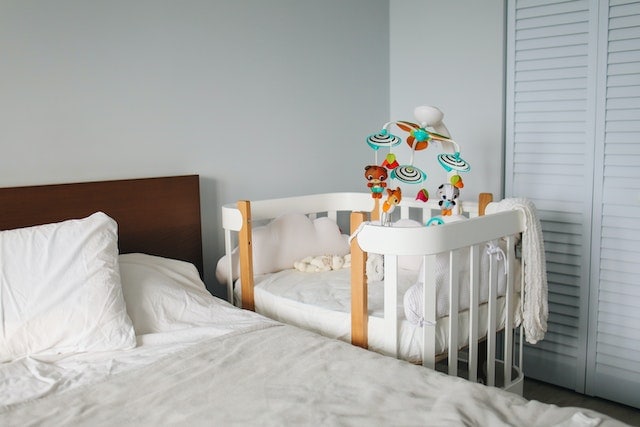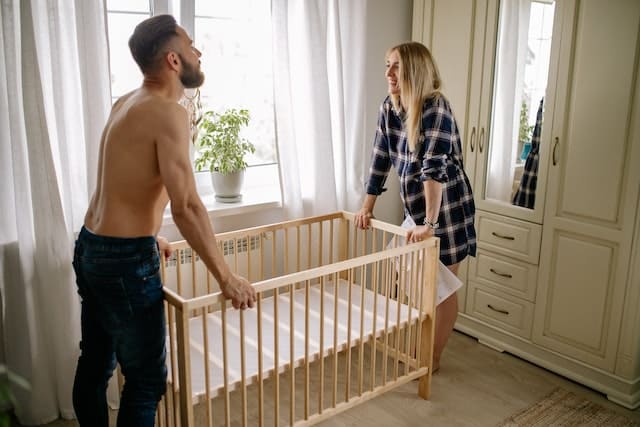Baby safe paint for cribs is an important consideration for parents who want to ensure the safety of their children. With so many different types of paint on the market, it can be difficult to know which ones are safe for use in a baby’s environment. This article will provide an overview of baby safe paints for cribs, including the types of paints available, key features to look for, and tips for selecting the right brand.
Understanding baby safe paints is important for parents who want to ensure that their baby’s environment is as safe as possible. These paints are specially formulated to be non-toxic and free from harmful chemicals that could harm a baby’s health. They are also designed to be durable and long-lasting, so they can withstand the wear and tear of a baby’s environment.
Key Takeaways
- Baby safe paints are specially formulated to be non-toxic and free from harmful chemicals.
- Parents should look for paints that are durable and long-lasting to withstand the wear and tear of a baby’s environment.
- When selecting a brand of baby safe paint, it’s important to consider factors such as indoor air quality, safety measures for food contact surfaces, and eco-friendliness.
Understanding Baby Safe Paints

When it comes to painting a crib for a baby, safety is the top priority. Traditional paints can contain harmful chemicals, such as volatile organic compounds (VOCs) and endocrine disruptors, which can be dangerous for a baby’s developing body. Therefore, it is important to use baby-safe paint that is non-toxic and free from harmful chemicals.
Baby-safe paint is typically made from natural ingredients, such as plant oils, resins, and natural pigments. These paints are also known as natural paints, and they are often zero VOC or low VOC. VOCs are chemicals that can evaporate into the air and cause health problems, such as headaches, nausea, and respiratory issues.
Zero VOC or low VOC paints are formulated to have minimal or no VOCs, making them safe for babies and adults alike. These paints are often labeled as VOC-free or zero-VOC, and they are a great choice for painting a crib.
In addition to VOCs, it is important to avoid other harmful chemicals, such as alkylphenol ethoxylates (APEs), which can be found in some traditional paints. APEs are toxic to aquatic life and can disrupt the endocrine system.
When choosing a baby-safe paint, it is important to look for a product that is specifically labeled as safe for use on cribs and other baby furniture. These paints have been tested and certified as safe for babies, so you can have peace of mind knowing that your baby is not being exposed to harmful chemicals.
Overall, using baby-safe paint is a simple and effective way to ensure that your baby’s crib is a safe and healthy environment. By choosing a natural, non-toxic paint, you can protect your baby from harmful chemicals and create a beautiful, safe space for them to sleep and play.
Types of Baby Safe Paints
When it comes to choosing a baby safe paint for cribs, there are several types of paints to consider. Here are some of the most popular options:
1. Water-Based Paints
Water-based paints are a great option for baby cribs as they are non-toxic and easy to clean up with soap and water. They are also low in volatile organic compounds (VOCs), which means they emit fewer harmful chemicals into the air. Some popular water-based paint brands include Fusion Mineral Paint, General Finishes Water Based Milk Paint, and FolkArt Home Decor Chalk Paint.
2. Milk Paints
Milk paints are another safe option for baby cribs. They are made from natural ingredients such as milk protein, lime, and clay. Milk paints are also low in VOCs and are easy to apply. Some popular milk paint brands include Old Fashioned Milk Paint, Miss Mustard Seed’s Milk Paint, and Real Milk Paint.
3. Chalk Paints
Chalk paints are a popular choice for furniture, including baby cribs. They have a matte finish and are easy to distress for a vintage look. Some popular chalk paint brands include Rust-Oleum Chalked Ultra Matte Paint, Retique It by Renaissance Furniture and Cabinet Paint, and Annie Sloan Chalk Paint.
It’s important to note that not all chalk paints are baby safe, so be sure to check the label for any harmful chemicals. Additionally, some chalk paints require a wax or sealant to make them durable enough for a baby crib.
When choosing a baby safe paint for cribs, always look for paints that are labeled as non-toxic and low in VOCs. It’s also a good idea to test the paint on a small area of the crib before applying it to the entire piece.
Key Features of Baby Safe Paints
When it comes to painting a crib, safety is the top priority for any parent. Baby safe paints are specially formulated to ensure that they do not contain any harmful chemicals that could harm a baby’s health. Here are some key features to look for when choosing a baby safe paint:
1. Hypoallergenic
Baby safe paints should be hypoallergenic, which means that they are less likely to cause an allergic reaction. This is especially important for babies who may have sensitive skin or allergies.
2. Low Odor
Baby safe paints should have a low odor, as strong fumes can be harmful to a baby’s developing lungs. Low odor paints are also more pleasant to use, as they do not have a strong chemical smell.
3. Smooth Finish
A smooth finish is important for a baby’s crib, as it makes it easier to clean and maintain. Baby safe paints should have a smooth finish that is easy to wipe down and keep clean.
4. Matte Finish
A matte finish is ideal for a baby’s crib, as it does not reflect light and is less likely to cause eye strain. Matte finishes also tend to be more forgiving, as they do not show imperfections as readily as glossy finishes.
5. Built-in Sealer
Some baby safe paints come with a built-in sealer, which helps to protect the paint from scratches and wear and tear. This is especially important for cribs, which can be subjected to a lot of use.
6. Natural Ingredients
Many baby safe paints are made with natural ingredients, such as plant-based fillers, natural pigments, beeswax, lime, clay, and powdered form. These ingredients are less likely to cause harm to a baby’s health, and are more eco-friendly than traditional paint.
7. Earth Pigments
Earth pigments are a type of natural pigment that is derived from rocks and minerals. They are non-toxic and environmentally friendly, and can be used to create a wide range of colors.
Overall, when choosing a baby safe paint for a crib, it is important to look for a product that is hypoallergenic, low odor, and has a smooth, matte finish. It should also be made with natural ingredients and earth pigments, and may have a built-in sealer for added protection.
Application of Baby Safe Paints

When it comes to painting cribs or any other baby furniture, safety is the top priority. Baby safe paints are specifically designed to be non-toxic and free from harmful chemicals, making them ideal for use on cribs, wooden furniture, and other baby furniture.
Before applying any paint, it is important to prepare the surface properly. If the furniture is already painted, it should be sanded down to remove any chipping or flaking paint. If the furniture is raw wood, it should be sanded to remove any rough spots or splinters.
Once the surface is properly prepared, the baby safe paint can be applied. It is important to choose a paint that is labeled as safe for use on baby furniture. The paint should be applied in thin, even coats, and allowed to dry completely between coats.
After the final coat of paint has dried, a topcoat can be applied for added durability. This will help to protect the paint and furniture from wear and tear, as well as making it easier to clean.
If the furniture needs to be repainted in the future, it is important to use a baby safe paint stripper and follow the same preparation and application steps as before. By following these guidelines, parents can ensure that their baby’s furniture is both beautiful and safe.
Selecting Baby Safe Paint Brands
When it comes to selecting a baby safe paint brand for cribs, there are several options available in the market. Some of the popular brands include Country Chic Paint, Lullaby Paints, Amy Howard Home, and One Step Paint. Here are some factors to consider when selecting a baby safe paint brand:
1. Ingredients
It is important to check the ingredients of the paint before buying it. Look for paints that are free from volatile organic compounds (VOCs), lead, and other harmful chemicals. VOCs are known to cause respiratory problems and can be harmful to babies who have weaker immune systems.
2. Certification
Check if the paint brand has any certifications or endorsements from reputable organizations such as Greenguard, which certifies products that have low chemical emissions. This will give you peace of mind knowing that the paint you are using is safe for your baby.
3. Durability
Babies tend to be messy, so it is important to select a paint brand that is durable and easy to clean. Look for paints that are scratch-resistant and can withstand frequent cleaning.
4. Color Options
While safety is the top priority, it is also important to consider the color options available. Some brands offer a wide range of colors to choose from, while others have limited options.
In conclusion, when selecting a baby safe paint brand for cribs, it is important to consider the ingredients, certification, durability, and color options available. By doing so, you can ensure that the paint you choose is safe for your baby and will last for years to come.
Importance of Indoor Air Quality

When it comes to painting a baby’s crib, one of the most crucial factors to consider is indoor air quality. Indoor air quality refers to the quality of the air inside a building, which can have a significant impact on our health and well-being.
Petrochemical solvents, commonly found in traditional oil-based paints, can emit harmful fumes that can be dangerous to infants. These fumes can cause respiratory problems, headaches, dizziness, and nausea. Additionally, vinyl, which is often used in the production of paint, can release volatile organic compounds (VOCs) that can be harmful to human health.
Therefore, it is essential to choose a baby-safe paint that is free of these harmful chemicals. Baby-safe paints are specifically formulated to be low in VOCs and petrochemical solvents, making them a safer choice for infants.
By choosing a baby-safe paint, parents can ensure that their child is not exposed to harmful chemicals that could impact their health. It is important to note that indoor air quality is not just important for babies but also for adults, as poor indoor air quality can lead to a range of health problems.
In conclusion, when painting a baby’s crib, it is essential to consider indoor air quality and choose a baby-safe paint that is free of harmful chemicals like petrochemical solvents and vinyl. This will help ensure that the baby’s environment is safe and healthy.
Safety Measures for Food Contact Surfaces
When it comes to painting a crib, it is important to consider the safety of the paint used, especially if it will come into contact with food. This is because babies tend to put everything in their mouths, including the paint on their cribs. Therefore, it is essential to choose a baby-safe paint that is non-toxic and safe for food contact surfaces.
One of the best options for natural wood finishes is plant oils, such as linseed oil, tung oil, and walnut oil. These oils are non-toxic, food-safe, and do not emit harmful fumes. They penetrate the wood and provide a protective layer that enhances the natural beauty of the wood. Plant oils are also easy to apply, maintain, and repair.
Coatings are another option for baby-safe paint. However, not all coatings are safe for food contact surfaces. It is important to choose a coating that is specifically designed for food contact surfaces, such as a water-based polyurethane or shellac. These coatings are non-toxic, odorless, and easy to clean. They provide a durable and protective layer that resists scratches, stains, and water damage.
When applying baby-safe paint, it is important to follow the manufacturer’s instructions carefully. This includes preparing the surface properly, using the right tools and techniques, and allowing adequate drying and curing time. It is also important to avoid painting in poorly ventilated areas and to wear protective gear, such as gloves and a mask.
In conclusion, when choosing a baby-safe paint for cribs, it is important to consider the safety of the paint used, especially if it will come into contact with food. Natural wood finishes, such as plant oils, and coatings, such as water-based polyurethane or shellac, are safe options for food contact surfaces. By following the manufacturer’s instructions and taking safety precautions, parents can ensure a safe and beautiful finish for their baby’s crib.
Eco-Friendly Paint Options
When it comes to painting a crib, parents want to ensure that the paint is not only safe for their baby but also environmentally friendly. Fortunately, there are several eco-friendly paint options available on the market.
One certification to look for is Green Seal, which is an independent non-profit organization that sets environmental standards for products. Paints that are Green Seal certified have undergone rigorous testing to ensure that they meet strict environmental and health criteria.
Another option is to choose paints that are specifically labeled as eco-friendly or non-toxic. These paints are typically made with natural ingredients and do not contain harmful chemicals such as volatile organic compounds (VOCs).
Some popular eco-friendly paint brands include ECOS Paints, AFM Safecoat, and Benjamin Moore’s Natura line. These paints use natural ingredients such as clay, plant oils, and minerals to create a safe and environmentally friendly product.
It’s important to note that while these paints are safer for babies and the environment, they may not be as durable as traditional paints. Parents should also be aware that even eco-friendly paints may contain small amounts of VOCs, so it’s important to follow proper ventilation and safety guidelines during and after painting.
Overall, choosing an eco-friendly paint option for a crib is a great way to ensure the safety of a baby while also being environmentally conscious.
Frequently Asked Questions
What kind of paint is safe to use on a baby crib?
When it comes to painting a baby crib, it is important to choose a paint that is safe for babies. The best type of paint to use on a baby crib is a non-toxic, water-based paint. Look for a paint that is labeled as “low-VOC” or “zero-VOC” to ensure that it is free of harmful chemicals.
Can you touch up paint on a crib?
Yes, you can touch up paint on a crib. However, it is important to use the same type of paint that was originally used on the crib. If the original paint was a non-toxic, water-based paint, then use the same type of paint for touch-ups.
Is Sherwin Williams paint safe for babies?
Sherwin Williams offers a variety of paints that are safe for use on baby cribs. Look for their “Harmony” line of paints, which are low-VOC and free of harmful chemicals.
What is the best spray paint for a baby crib?
Spray paint is not recommended for use on baby cribs, as it can be difficult to control the amount of paint that is applied. If you must use spray paint, choose a non-toxic, water-based spray paint that is labeled as safe for use on baby items.
Where can I find baby safe paint for crafts?
Baby safe paint for crafts can be found at most craft stores, as well as online. Look for paints that are labeled as non-toxic and safe for use on baby items.
Is Real Milk Paint safe for baby cribs?
Real Milk Paint is a natural, non-toxic paint that is safe for use on baby cribs. It is made from all-natural ingredients and is free of harmful chemicals. However, it is important to note that Real Milk Paint may not be as durable as other types of paint, so it may need to be reapplied more frequently.

Iesha is a loving mother of 2 beautiful children. She’s an active parent who enjoys indoor and outdoor adventures with her family. Her mission is to share practical and realistic parenting advice to help the parenting community becoming stronger.
